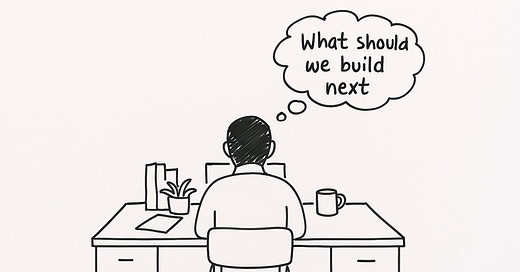How we do the work is ever changing, that's why the "Job of Product teams" exists and is valuable
In Product going faster is hardly ever enough. New tech, even tech that's incredibly disruptive, doesn't change the focus of the work product teams do.
When AI <New Tech Here> Changes the Work, Not the Job
I spent years helping photographers navigate a shift in their tools. Cameras got smarter, autofocus, exposure presets, subject tracking. That didn’t make working in photography easier, it absolutely changed what it meant to be a working photographer. You didn’t need to master the light meter. You needed to know when to trust it and when to override it. That’s what kept you relevant.
We’re watching the same pattern now, but the tools are different. AI is reshaping how product teams, engineers, and operations lead work. Some organizations are doing this by eliminating jobs, which is a strong indication they don’t believe product is very important right now. Product talent soldiers on, altering how those jobs are practiced.
The Work Shifts, Even If the Title Doesn’t
LLM’s accelerates what used to be hard. Drafting a spec? Writing a summary? Exploring design options? These can start with a prompt, not a blank page. The craft isn’t gone, it’s starting further down the track.
This means the role of the product manager, or strategist, or engineering lead—hasn’t disappeared. But the workflow has. And that demands a different kind of leadership.
“Mastering <insert hot tech here>” is, we must agree, a terrible focus for building a viable, mission aligned, financially self sustaining product. That requires a product team and always will. Product management can’t be both separated from understanding the capabilities of expert craftsmanship, and simply about monitoring how we use tools, “our hot tech”, to improve the reach and capabilities of “our amazing process”.
### Product Teams as Translators
In outsourced manufacturing or globally distributed teams, it’s product not ops that connects strategy to execution. The product team holds customer knowledge, design intent, and practical use cases. As delivery tools speed up, this role becomes even more central.
Product teams are translating intent into something a global delivery team or automated process can act on. They’re not just building the product. They’re shaping how it’s understood, sourced, and scaled.
Teams Can Ship Faster Than Their Habits
AI in the new hot tech, and it’s a very disruptive. AI compresses the time between idea and prototype. But many team processes still assume week-long discovery, stakeholder alignment rituals, and sprint planning cycles built for slower iteration.
That mismatch creates friction. It’s not the team’s fault, they were trained for a different speed. But it’s time to adjust. New tools mean new patterns. The teams that adapt fastest won’t be the ones with the best tech. They’ll be the ones with the best *reframing* of how they work.
Expertise Still Matters, The “How We Do It” Just Looks Different
Tools can assist. They can even summarize. But they don’t carry judgment, make tradeoffs, or rebuild trust between departments. That’s the human work. And it’s what keeps expertise relevant.
A good prompt and dynamite data flow, an agentic system of LLMs, even a few years from new real actual _General Intelligence_ Ai won’t deliver the real work of product. Hot tech, can’t create an authentic _human_ experience. It can’t because the hot tech isn’t what a customer is buying from you. The difference between a working professional photographer and someone with a professional camera is evident in the product, the pictures, not the camera, or the printer, or the digital filters or any of that.
A great product leader today doesn’t just know how to define a roadmap—they know how to reframe the problem when the tools shift the boundaries.
Final Thought: You’re the Adopter *and* the Creator
The biggest lesson? You’re not just adapting to AI or any hot tech. You’re building the products that will shape how others adapt.
That means you need to understand the transformation in your own workflow, because it will influence what you ask your tools and teams to do. The better you navigate that shift, the better you’ll be at guiding your own customers through theirs.
The job title might not change. But the work will. Let’s stay curious, stay grounded, and help others adapt as we adapt ourselves.





